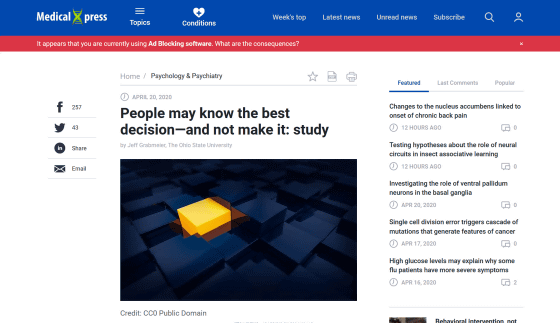Even if we know 'what is the best decision,' human beings will be drawn by the latest results and make wrong decisions.

When it comes to the need to make a decision, it is often assumed that one makes the best decision based on the knowledge he has. But Associate Professor
Mouse tracking reveals structure knowledge in the absence of model-based choice | Nature Communications
https://www.nature.com/articles/s41467-020-15696-w
People may know the best decision—and not make it: study
https://medicalxpress.com/news/2020-04-people-decisionand.html

When people make something wrong, many think it's because they didn't have enough knowledge to make the right decision. But Krajbich says that even if he knows 'the most likely decision to work out,' people rely on intuition, habits, and finally good experience to make decisions.
To study the psychology of people making decisions, Krajbich and a former graduate student
Subjects participating in the game first click on one of the two shapes displayed at the top of the screen with the mouse. Then move the mouse cursor to the bottom of the screen, and when the cursor crosses the invisible line drawn at the bottom of the screen, the shape displayed at the top disappears and instead another shape appears at the bottom left or bottom right of the screen . By clicking the figure displayed at the bottom of the screen, the subject can receive a reward, and after obtaining the reward, move the cursor to the upper part of the screen and cross the invisible line, the two figures are displayed again at the top of the screen and the next It was a mechanism to move to the trial.

It seems that there was a certain pattern in the figure display, and from the results of tracking the trajectory of the mouse that the subject moved, it was confirmed that 56 of 57 subjects learned the figure display pattern firmly. . In other words, after clicking on the shape at the top, move the mouse cursor toward the position where the next shape will be displayed based on the learned pattern, and you can see the movement to get the reward efficiently. That's right.
However, the research team designed the game so that the figure at the bottom of the screen was displayed at a place outside the pattern with a probability of 10 to 40%. Then, in the trial after the figure was accidentally displayed at a place outside the pattern, the cursor was moved toward the middle of the screen so that the figure may be displayed in any direction, not according to the pattern that the subject has learned so far. It was said that the ratio of moving the cursor or moving the cursor in the opposite direction to the learned pattern was high.
Overall, it's not very likely that the shape would appear outside the pattern, so the best way for the subject was to always move the mouse according to the learned pattern, rather than being pulled over by previous attempts. However, the research team pointed out that the subjects were unable to select the best pattern, as it happened to be pulled out of the results of the previous trial. 'In our research, people knew how to work the best, but they didn't use that knowledge,' Krajbich said.

Krajbich explains the results of this research in realistic situations. For example, suppose it was clear that the shortest route for a person “A” to get home from work was through the “main street”. However, one day, because it happened to be congested on the main street due to an event, A was able to use another 'Spruce Street' to get home just a little earlier than usual.
The next day, when asked if person A would use Main Street or Spruce Street to return, Krajbich said, 'I happened to use Spruce Street to go home yesterday. There is a high possibility ”. Despite the fact that statistically, it is known that using Main Street will make it easier to return home, but the percentage of people who make 'wrong decisions' due to yesterday's experience is high. 'There's a tension between the decisions you make statistically and the ones that work the most recently,' says Krajbich.
“It can be difficult to tell whether a decision you made was good or bad, based only on the outcome of your decision. Sometimes you make a good decision and you are unlucky Occasionally, it happens, but it happens, 'said Krajbich. He pointed out that the benefits of following the best decision are not always obvious, and that if the difference in success rate is small, it is likely to be drawn to the previous result and it is likely that you do not utilize the knowledge you have.

Related Posts:
in Science, Posted by log1h_ik







